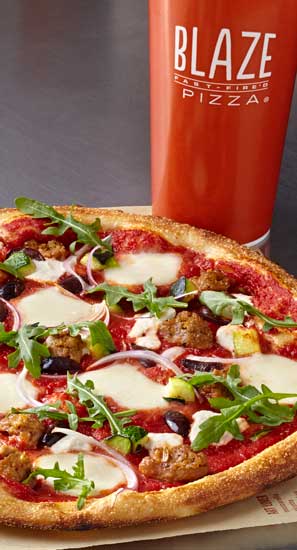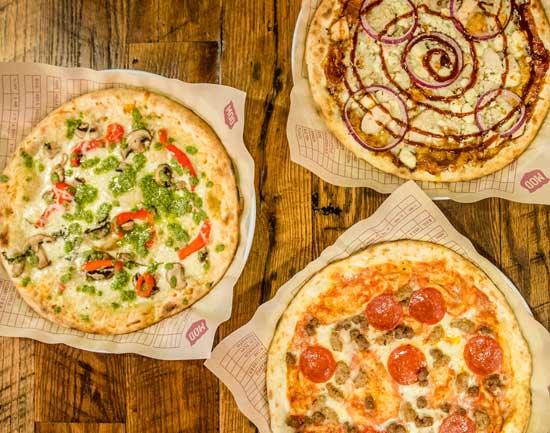Fast-Casual Pizzerias Driving Innovation (Online Exclusive)
Personalized options are key to pizza’s strong performance in the foodservice segment.
 “Fast-casual pizza has taken the world by storm,” says Sanjay Gummalla, vice-president of regulatory and technical affairs for the American Frozen Foods Institute. Over the past few years, a growing number of restaurants offering quickly cooked pizzas made right in front of consumers have popped up around the United States. Similar to Chipotle, these restaurants display all their ingredient options behind a glass counter, and consumers can opt either to build their own pie or choose from a variety of thoughtfully designed favorites. Thanks to superhot ovens, the finished pizzas can be ready in as little as 90 seconds.
“Fast-casual pizza has taken the world by storm,” says Sanjay Gummalla, vice-president of regulatory and technical affairs for the American Frozen Foods Institute. Over the past few years, a growing number of restaurants offering quickly cooked pizzas made right in front of consumers have popped up around the United States. Similar to Chipotle, these restaurants display all their ingredient options behind a glass counter, and consumers can opt either to build their own pie or choose from a variety of thoughtfully designed favorites. Thanks to superhot ovens, the finished pizzas can be ready in as little as 90 seconds.
“In the United States, an explosion of build-your-own, fast casual concepts … are capitalizing on Millennial-driven trends that offer consumers a more personal experience than the largest chains can provide,” observes Euromonitor in a 2016 blog post. Indeed, these fast-casual concepts meet consumers’ need for quality and innovation, says Kelly Weikel, director of consumer insights for Technomic, while also providing speed and convenience.
These restaurants also give diners more transparency and control than other dining establishments, and Greg Dunn, owner of Persona Pizzeria’s Chicago location, says that this ability to interact with their food has spurred diners to make more creative choices, which may appeal to Millennials’ desire for a steady stream of unique food choices. “Folks seem to love to see their pizza made right in front of them, often trying new topping combinations based on what is catching their eye that day,” he says. “We also know that folks sometimes are inspired to try new combinations based on what they see people at other tables enjoying.”
 Some of these fast casuals are attempting to link their brand to “local” by customizing their stores and offerings to individual cities, such as the Hungarian peppers from the Pacific Northwest used by MOD Pizza in its Seattle-area locations. We vary our menus from location to location, says Glenn Cybulski, founder of Persona Pizzeria, a chain of Roman-style fast-casual pizzerias that originated in California, which Cybulski refers to as the “birthplace of new pizza toppings.” In its newly opened Chicago outpost, Persona serves stromboli, filled pizza pockets popular in that city.
Some of these fast casuals are attempting to link their brand to “local” by customizing their stores and offerings to individual cities, such as the Hungarian peppers from the Pacific Northwest used by MOD Pizza in its Seattle-area locations. We vary our menus from location to location, says Glenn Cybulski, founder of Persona Pizzeria, a chain of Roman-style fast-casual pizzerias that originated in California, which Cybulski refers to as the “birthplace of new pizza toppings.” In its newly opened Chicago outpost, Persona serves stromboli, filled pizza pockets popular in that city.
Fast casuals also allow consumers to make healthier choices; the crusts are inherently thinner to be able to work in these superhot ovens, and brands like & Pizza also offer gluten-free and ancient grain–based crusts. The ability to choose their own ingredients and add as few or many as they like helps add to their better-for-you appeal, observes Weikel. “I think that perhaps it’s the visual connection—seeing the variety of fresh toppings that may help increase veggie consumption, for example—that makes fast casual a great option for those who want to marry ‘fresh and healthy’ with maximum convenience,” says Dunn.
This idea of lighter pizzas also may explain why fast casuals are bringing pizza into a little-addressed daypart: lunch. Though there are some personal-sized options in the freezer case, pizza has not generally been linked with lunch because people tend not to think ahead to bring frozen pizza into the office, says Weikel. She thinks there could be some untapped opportunities available for manufacturers who want to try to compete with fast casuals within this space. Indeed, according to Tricia White, vice-president of product development for Schwan’s Shared Services, “Growth continues in single-serve formats and microwaveable pizzas, which points to how consumers fit pizza into their busy lives. It’s completely acceptable to have pizza any time and for any daypart.”
To successfully compete with fast casuals, whether as a quickservice restaurant, retail manufacturer, or fellow fast-casual operator, the key to success will lie in attention to quality and taste. “At the end of the day, it’s not about just being a ‘good fast-casual’ restaurant,” says Dunn. “Your food has to stack up with that offered by all other dining options as well.”
Melanie Zanoza Bartelme is associate editor of Food Technology magazine ([email protected]).
